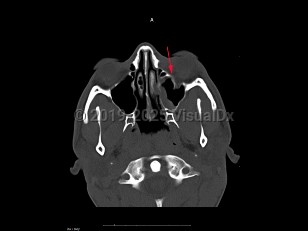Emergency: requires immediate attention
Blow-out fracture of orbit - External and Internal Eye
Alerts and Notices
Important News & Links
Synopsis
After sustaining a blunt force injury with an object larger in size than the globe, such as a fist or ball, the orbit is at risk of a "blow-out fracture." Although the lamina papyracea is the thinnest bone of the orbit, the orbital floor is the most common type of orbital fracture. This type of fracture tends to occur just behind the orbital rim but may involve the rim itself.
Patients often present with pain and tenderness to the periorbital region, which may worsen on attempted upgaze. They may note diplopia if there is limited motility of the involved eye. Signs of orbital floor blow-out fracture may include ecchymosis, enophthalmos, hypesthesia of the cheek, crepitus, and restricted eye movements, particularly in upgaze.
As the swelling decreases with time after the trauma, enophthalmos becomes more apparent in larger fractures. In many orbital fractures, swelling and ecchymosis are the only signs.
Pediatric Patient Considerations:
Children are at an increased risk of severe muscle entrapment of the inferior rectus with associated nausea and vomiting. This type of entrapment is considered a surgical emergency, as the tissue can become ischemic if not released.
Patients often present with pain and tenderness to the periorbital region, which may worsen on attempted upgaze. They may note diplopia if there is limited motility of the involved eye. Signs of orbital floor blow-out fracture may include ecchymosis, enophthalmos, hypesthesia of the cheek, crepitus, and restricted eye movements, particularly in upgaze.
As the swelling decreases with time after the trauma, enophthalmos becomes more apparent in larger fractures. In many orbital fractures, swelling and ecchymosis are the only signs.
Pediatric Patient Considerations:
Children are at an increased risk of severe muscle entrapment of the inferior rectus with associated nausea and vomiting. This type of entrapment is considered a surgical emergency, as the tissue can become ischemic if not released.
Codes
ICD10CM:
S02.30XA – Fracture of orbital floor, unspecified side, initial encounter for closed fracture
S02.30XB – Fracture of orbital floor, unspecified side, initial encounter for open fracture
SNOMEDCT:
263167007 – Blow out fracture of orbit
S02.30XA – Fracture of orbital floor, unspecified side, initial encounter for closed fracture
S02.30XB – Fracture of orbital floor, unspecified side, initial encounter for open fracture
SNOMEDCT:
263167007 – Blow out fracture of orbit
Look For
Subscription Required
Diagnostic Pearls
Subscription Required
Differential Diagnosis & Pitfalls

To perform a comparison, select diagnoses from the classic differential
Subscription Required
Best Tests
Subscription Required
Management Pearls
Subscription Required
Therapy
Subscription Required
References
Subscription Required
Last Updated:08/22/2013
Emergency: requires immediate attention
Blow-out fracture of orbit - External and Internal Eye

